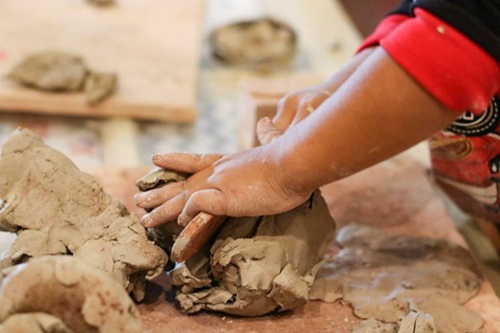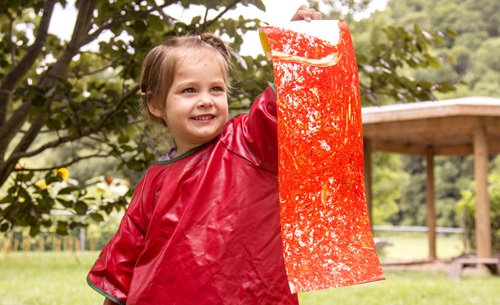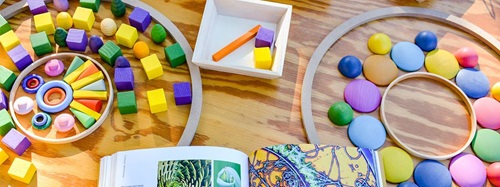Loose Parts: Inspiring Play in Young Children
| June 2015We have often marveled at the long hours children can spend playing with simple materials like boxes, rocks, shells, sand, or water. Our observations have led us to question the conventional wisdom of providing children with sophisticated toys. As you’ve probably noted yourself, children are often more interested in the packaging than in the toys themselves.
Children usually prefer play that stimulates their curiosity and gives free reign to their imaginations and creativity. We believe that one of the best ways to enhance their natural curiosity is to introduce a wide variety of the materials we call “loose parts” into their play settings.
What Are Loose Parts?
In early childhood education settings, loose parts mean alluring, beautiful, found objects and materials that children can move, manipulate, control, and change while they play. Children can carry, combine, redesign, line up, take apart, and put loose parts back together in almost endless ways. The materials come with no specific set of directions, and they can be used alone or combined with other materials. Children can turn them into whatever they desire: a stone can become a character in a story; an acorn can become an ingredient in an imaginary soup. These objects invite conversations and interactions, and they encourage collaboration and cooperation. Put another way, loose parts promote social competence because they support creativity and innovation. All of these are highly valued skills in adult life today.
Loose parts possess infinite play possibilities. They offer multiple rather than single outcomes: no specific set of directions accompanies them; no single result is inevitable. Unlike a jigsaw puzzle, whose pieces are meant to be fitted together in a specific way to make a single picture, loose parts can be joined in many ways. A scarf, for example, can become a blanket to swaddle a baby, a platform for a picnic, a fishing pond, a cover for a fort, or a veil covering the face of a bride.
Origin of Loose Parts
Children for generations have used found materials in their play from rocks and sticks to tin cans and wire. In his article “How NOT to Cheat Children: the Theory of Loose Parts,” the British architect Simon Nicholson coined the term “loose parts” to describe open-ended materials that can be used and manipulated in many ways (1971). Nicholson saw people of every age as potentially creative. Environments, he believed, offer many ways for children to interact with variables such as gravity, sounds, chemical reactions, concepts, words, and people. For Nicholson, the richness of an environment depended on the opportunities it provided for making connections. “In any environment,” he writes, “both the degree of inventiveness and creativity, and the possibility of discovery, are directly proportional to the number and kind of variables in it” (30). Take, for example, a beach: it is filled with loose parts—rocks, shells, beach glass, plants, feathers. When children play in such a setting, they can move around, making use of any or all of the found objects, devising spaces and structures that can entertain them for hours. This isn’t only fun but it also helps them develop higher levels of critical thinking and creativity.
When an environment is rich in loose parts, children are likely to discover multiple ways to manipulate them and new ways of thinking or processing the knowledge learned by playing with the materials. Children can use flat tree cookies to serve as a sturdy base for a tall tower, stepping stones to lead them safely across an imaginary river filled with hungry alligators, a steering wheel for their race car, or a lily pad to shelter frogs. They become more creative and flexible in their thinking while satisfying their ever-growing curiosity and love for learning.
The Value of Loose Parts
Children prefer loose parts. Anyone who has watched children play with toys or playground equipment knows that they quickly tire of things with a sole purpose. Once they've mastered the key function of an object—pushing the button to make a figure pop up or climbing a ladder, for example—they are ready to move on. The intrigue and the challenge are gone. In other words, children make their play choices based on how much variability those materials offer. A stick is a richer choice than a slide because it can become a fishing pole, a spoon for stirring a concoction, a magic wand, or a balance beam for snails. Loose parts offer almost numberless variables, prompting children to create their own stories.
With so many materials available for ECE classrooms, you need to make choices that maximize children’s development and make sense financially. Today, teachers are often expected to provide classroom materials out of their own pockets. Happily, loose parts can often be had for free, and they offer a bonus: they encourage you, and the children’s parents, to reuse, renew, and recycle. Write a note to the children’s families asking them to collect potentially rich materials around their homes to add to the classroom. Provide a list of suggested items (small boxes, jar lids, buttons, fabric). Also, post your list in the classroom or distribute it at school events.
Loose Parts Support the Curriculum
Loose parts offer many possibilities for open-ended learning. Especially in ECE programs where standards and ditto sheets are threatening to take over, advocate for loose parts as they support the acquisition of skills that children are required to demonstrate when they enter kindergarten.
Math
Children acquire their first math skills and numerical concepts when they manipulate small loose parts, like blocks and bottle caps, by sorting and classifying, and combining and separating them. They learn one-to-one correspondence when they make connections among loose parts. Once they begin integrating loose parts into their games, you commonly hear them start to count and see them arranging the parts in specific sequences, patterns, and categories by color, type, number, and class. Loose parts lend themselves to classification. The concept of measurement becomes clear when children play with tools like cups, sticks, funnels, and sifters. Measurement, equivalency, balance, spatial awareness, conservation, and logical classification are precursors to higher mathematical skills that loose parts readily support.
Physical Science
Loose parts help children investigate and actively construct ideas and explanations about physical properties of the nonliving world. Children gain deeper knowledge of how things work when they can experiment with stacking boxes, tubes, and bottles. They can also test multiple hypotheses involving gravity, force, weight, distance, and height with these materials. Children learn that things move in many various ways (motion) through playing with loose parts that can be pulled and pushed to start, stop, or change their movement. Wooden boards, gutters, and balls help them investigate inclines and gravity. Prisms and open-ended materials that are transparent, translucent, or opaque on a light table or overhead projector help children experiment with color, shadows, and reflected or refracted light.
Language and Literacy
Loose parts promote language development when children use them as props to engage in rich conversations and storytelling with peers and adults. Describing the items they manipulate, children can test new, complex words and engage in productive arguments that increase their critical-thinking skills. They make connections between loose parts, the books they have read, and the stories they have heard. They use loose parts to plan and draw their ideas and interactions. Ample, continuous use of loose parts helps children improve their memories, vocabularies, and literacy.
Art
Children often express their ideas and feelings through art. An open art studio offers them tools and materials for telling their stories. Adding loose parts to the art area can enhance their creativity and help them extend their ideas and questions. When loose parts are added to your art center, they offer children invitations to draw, sculpt, collage, explore, and extend their ideas. Such opportunities shouldn't be confined to the art area though. Fill your indoor and outdoor settings with open-ended resources to encourage creative expression everywhere. Children’s sense of beauty can be as easily seen in their arrangements of sticks lined up side by side, wooden planks propped symmetrically against a lodge, rock mosaics laid in sand, and pinecones arranged in spirals.
Movement and Music
Music and movement captures children’s attention and hearts. Movement for children mostly takes place through self-directed, self-initiated play as they freely move their bodies. Movement possibilities with loose parts such as scarves, hoops, and ribbons are endless, and provide opportunity for children to improvise. Musical play often means hitting items as hard as possible to see how they sound, and loose parts offer almost limitless opportunities to explore sounds that can be exuberant, random, noisy, and chaotic or quiet, gentle, and focused. Almost all children will naturally have the ability to interact with music.
We hope that you are inspired by this book to add more loose parts to children’s play. When you provide loose parts and have an open mind about how they may be used, the children will surprise and delight you with what they create and learn.
This article is excerpted from Chapter 1: Daly, Lisa, and Miriam Beloglovsky. 2015. Loose Parts: Inspiring Play in Young Children. Minnesota: Redleaf Press.

Copyright © Redleaf Press. Reprinted with permission. All rights reserved. Visit us at www.RedLeafPress.com.











